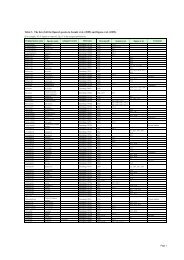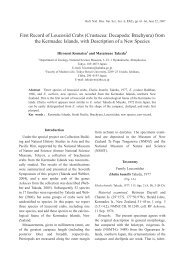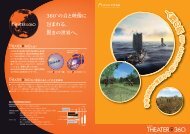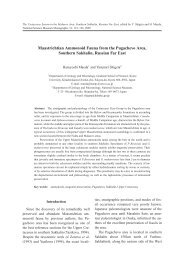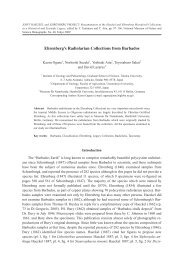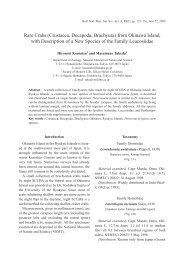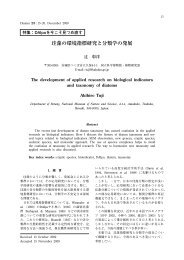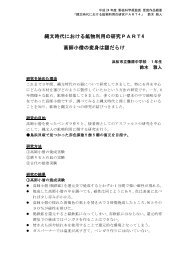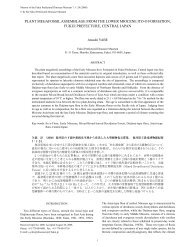The Identity of Cyclotella glomerata Bachmann and Discostella ...
The Identity of Cyclotella glomerata Bachmann and Discostella ...
The Identity of Cyclotella glomerata Bachmann and Discostella ...
You also want an ePaper? Increase the reach of your titles
YUMPU automatically turns print PDFs into web optimized ePapers that Google loves.
Bull. Natn. Sci. Mus., Tokyo, Ser. B, 32(1), pp. 9–14, March 22, 2006<br />
<strong>The</strong> <strong>Identity</strong> <strong>of</strong> <strong>Cyclotella</strong> <strong>glomerata</strong> <strong>Bachmann</strong> <strong>and</strong> <strong>Discostella</strong><br />
nipponica (Skvortzov) Tuji et Williams comb. et stat. nov.<br />
(Bacillariophyceae) from Lake Kizaki, Japan<br />
Akihiro Tuji 1 <strong>and</strong> David M. Williams 2<br />
1 Department <strong>of</strong> Botany, National Science Museum,<br />
Amakubo 4–1–1, Tsukuba, 305–0005, Japan<br />
E-mail: tuji@kahaku.go.jp<br />
2 Department <strong>of</strong> Botany, <strong>The</strong> Natural History Museum,<br />
Cromwell Road, London SW7 5BD, U.K.<br />
Abstract Type material <strong>of</strong> <strong>Cyclotella</strong> <strong>glomerata</strong> <strong>Bachmann</strong> <strong>and</strong> seven recently collected samples<br />
were examined to establish the identity <strong>of</strong> this species. C. <strong>glomerata</strong> has a central rimoportula at<br />
the central area <strong>of</strong> the valve face <strong>and</strong> forms colonies; several marginal fultoportulae occur on the<br />
ribs. Thus, this taxon is not a member <strong>of</strong> the new genus <strong>Discostella</strong>, which includes the <strong>Cyclotella</strong><br />
stelligera group, but is similar to other species in <strong>Cyclotella</strong>.<br />
In addition, isotype material <strong>of</strong> C. <strong>glomerata</strong> f. nipponica Skvortzov was examined. It does not<br />
share significant characters with C. <strong>glomerata</strong> but has characters that place it in <strong>Discostella</strong>. Thus,<br />
we propose the new combination <strong>Discostella</strong> nipponica (Skvortzov) Tuji et D. M. Williams.<br />
Key words: <strong>Cyclotella</strong> <strong>glomerata</strong> f. nipponica Skvortzov, <strong>Discostella</strong> nipponica (Skvortzov) Tuji<br />
et D. M. Williams, <strong>Cyclotella</strong> <strong>glomerata</strong> <strong>Bachmann</strong>, <strong>Discostella</strong> <strong>glomerata</strong> (<strong>Bachmann</strong>) Houk,<br />
Wolfgangsee<br />
Introduction<br />
<strong>Cyclotella</strong> <strong>glomerata</strong> <strong>Bachmann</strong> was first described<br />
by <strong>Bachmann</strong> (1911) from Zugersee (<strong>The</strong><br />
Lake <strong>of</strong> Zug), Switzerl<strong>and</strong>. This taxon has been<br />
reported worldwide as a planktonic species (e.g.<br />
Krammer & Lange-Bertalot 1991, Tuji & Houki<br />
2001, Houk & Klee 2004). Krammer & Lange-<br />
Bertalot (1991) described this taxon as part <strong>of</strong><br />
the “<strong>Cyclotella</strong> stelligera sippen complex”. Tuji<br />
& Houki (2001) reported this taxon from Lake<br />
Biwa, illustrated with an SEM, suggesting that it<br />
was a member <strong>of</strong> the “<strong>Cyclotella</strong> pseudostelligera<br />
group”. Recently, Houk & Klee (2004) transferred<br />
this taxon to the new genus <strong>Discostella</strong><br />
Houk et Klee, which included the <strong>Cyclotella</strong> stelligera<br />
group. All previous reports <strong>of</strong> <strong>Cyclotella</strong><br />
<strong>glomerata</strong> have included it in the <strong>Cyclotella</strong> stelligera<br />
/ pseudostelligera group.<br />
<strong>Bachmann</strong>’s original figures (1911: Figs<br />
106–108) <strong>and</strong> the illustrations <strong>of</strong>fered by Krammer<br />
& Lange-Bertalot (1991: Taf. 49), depict<br />
specimens in colonies <strong>of</strong> many cells. Since the<br />
descriptions <strong>of</strong> species placed in the genus <strong>Discostella</strong><br />
have no central rimoportulae nor do they<br />
form colonies, this leaves problems with the inclusion<br />
<strong>of</strong> C. <strong>glomerata</strong> in <strong>Discostella</strong>.<br />
In addition, Skvortzow (1936) described the<br />
form C. <strong>glomerata</strong> f. nipponica Skvortzov from<br />
Lake Kizaki, Japan. Skvortzov’s original illustration<br />
is too simple to be certain <strong>of</strong> its identity <strong>and</strong><br />
his name has not been used in any floral reports<br />
from Japan.<br />
In this study, we have examined specimens<br />
from <strong>Bachmann</strong>’s type slide <strong>of</strong> C. <strong>glomerata</strong>,<br />
Hustedt’s slides, <strong>and</strong> several recently collected<br />
samples, from Wolfgangsee, Austria, <strong>and</strong> isotype<br />
material <strong>of</strong> C. <strong>glomerata</strong> f. nipponica, in an attempt<br />
to clarify the taxonomy <strong>of</strong> C. <strong>glomerata</strong>.<br />
Materials <strong>and</strong> Methods<br />
A slide prepared by <strong>Bachmann</strong> from Zugersee,<br />
the type locality <strong>of</strong> <strong>Cyclotella</strong> <strong>glomerata</strong>, <strong>and</strong> la-
2 Akihiro Tuji <strong>and</strong> David M. Williams<br />
belled AC2/57 in BRM was examined. Another<br />
slide from Zugersee labelled 136/07 as well as<br />
raw material (E1305, Meister 589, from BRM;<br />
material collected by Meister on 3rd May 1906)<br />
were examined. <strong>The</strong> slides in BRM with specimens<br />
<strong>of</strong> <strong>Cyclotella</strong> <strong>glomerata</strong>, numbered AC1/20<br />
<strong>and</strong> AC1/21 <strong>and</strong> prepared by Hustedt from Wolfgangsee<br />
material, were also examined. Further,<br />
six samples (TNS-AL-55781–55784, 55789–<br />
55790 in TNS) collected from Wolfgangsee by<br />
A.Tuji on 15th–18th August 2005, were used for<br />
SEM <strong>and</strong> LM observation <strong>of</strong> C. <strong>glomerata</strong>.<br />
Raw material from Lake Kizaki (TNS-AL-<br />
55512 in TNS), thought to be isotype material <strong>of</strong><br />
Skvortzov’s (1936) earlier collection (Tuji 2003,<br />
Ohtsuka & Tuji 2003), was used to examine<br />
specimens <strong>of</strong> C. <strong>glomerata</strong> f. nipponica Skvortzov.<br />
Results<br />
Specimens <strong>of</strong> two taxa from <strong>Cyclotella</strong> (or<br />
<strong>Discostella</strong>) were observed in slide AC2/57 (pl. 1<br />
figs. 1, 3-6), collected from Zugersee (the type<br />
locality <strong>of</strong> C. <strong>glomerata</strong>) <strong>and</strong> Hustedt’s slide<br />
AC1/20 <strong>and</strong> AC1/21 (pl. 1 fig. 2) from Wolfgangsee.<br />
Specimens <strong>of</strong> one taxon have a circlular<br />
central pattern with a central fultoportula (pl. 1<br />
fig. 3), the other has a ring <strong>and</strong> stelligeloid central<br />
pattern with no central fultoportulae (pl. 1<br />
fig. 4). Both taxa are easily distinguished using<br />
the central pattern <strong>and</strong> the existence <strong>of</strong> central<br />
fultoportula(e). <strong>The</strong> taxon with the central fultoportula<br />
agrees with the original description <strong>of</strong> C.<br />
<strong>glomerata</strong> <strong>and</strong> can be identified as such.<br />
<strong>The</strong> individuals in the sides, AC2/57 (pl. 1<br />
figs. 1, 3–6), AC1/20, AC1/21 (pl. 1 fig. 2),<br />
136/07 (pl. 1, figs. 7–9) <strong>and</strong> TNS-AL-55790sa<br />
(pl. 1 figs. 10–17), all share the similar dimensions<br />
<strong>of</strong> cell size, density <strong>of</strong> striae, the form <strong>of</strong><br />
central area, the possession <strong>of</strong> one to several<br />
small central fultoportula <strong>and</strong> the character <strong>of</strong><br />
colony formation characteristics (pl. 1, figs. 1, 2,<br />
17) that can be observed on the micrograph in<br />
Krammer & Lange-Bertalot (1991: Taf. 49, fig.<br />
11), except for two points. <strong>The</strong>ir specimens were<br />
from Wolfgangsee (BRM AC1/20). <strong>The</strong> individuals<br />
in slide 136/07 do not appear to form<br />
colonies—although it is possible that they could<br />
be destroyed during the cleaning process.<br />
Colonies were not observed in recently collected<br />
material after they were subjected to the cleaning<br />
process. <strong>The</strong> cell size <strong>of</strong> individuals in the slide<br />
136/07 <strong>and</strong> TNS-AL-55790sa are larger than others,<br />
but the dimensions overlap. <strong>The</strong> ultra-structure<br />
<strong>of</strong> the individuals in TNS-AL-55790 from<br />
Wolfgangsee also agree in their main features<br />
with the structure <strong>of</strong> specimens from slide E1305<br />
from Zugersee.<br />
A description is as follows: cells 3–10 mm in<br />
diameter, 2.5–4.5 mm in depth, attached at the<br />
valve face, forming colonies with few to many<br />
cells (pl. 1 figs. 1, 2, 17). In SEM, one small central<br />
fultoportula with two pore covers <strong>and</strong> cowlings,<br />
are present in each valve (pl. 2 figs. 1–6).<br />
Marginal fultoportulae, also with two pore covers<br />
<strong>and</strong> cowlings, exist close to the valve ends <strong>and</strong> at<br />
the end <strong>of</strong> every three to four ribs (pl. 2 figs. 2, 3,<br />
6). <strong>The</strong> ribs on the marginal fultoportulae are<br />
more depressed than the other ribs (pl. 2 figs.<br />
2–4). Rimoportulae occur on the valve face,<br />
close to valve face/mantle junction (pl. 2 fig. 4).<br />
C. <strong>glomerata</strong> f. nipponica is rare the isotype<br />
material from Lake Kizaki. <strong>The</strong> specimens that<br />
were found had cells <strong>of</strong> 3–4 mm in diameter, with<br />
striae 18 in 10 mm (pl. 3 figs. 1–7). <strong>The</strong> specimens<br />
occur only as unicells, not in colonies. No<br />
central fultoportula was observed in the SEM, although<br />
marginal fultoportulae, with long tubes<br />
<strong>and</strong> two cowlings, occur at the valve face/mantle<br />
junction (pl. 3 figs. 6–7). <strong>The</strong> ribs branch on the<br />
valve face, while they strongly branch on the<br />
mantle. A small sessile rimoportula occurs on the<br />
valve/mantle junction (pl. 3 figs. 1–7).<br />
Discussion<br />
It seems appropriate to designate BRM slide<br />
AC2/57 from Zugersee as lectotype for <strong>Cyclotella</strong><br />
<strong>glomerata</strong> <strong>Bachmann</strong>.<br />
Our observations show that C. <strong>glomerata</strong><br />
forms colonies, has one to three central fultopor-
<strong>The</strong> <strong>Identity</strong> <strong>of</strong> <strong>Cyclotella</strong> <strong>glomerata</strong> <strong>and</strong> <strong>Discostella</strong> nipponica 3<br />
tulae with marginal fultoportulae occurring on<br />
the ribs, observations supported by the original<br />
figures presented by <strong>Bachmann</strong> (1911). <strong>The</strong>se<br />
characters are not part <strong>of</strong> the genus <strong>Discostella</strong><br />
as described by Houk & Lee (2004). <strong>The</strong> SEM<br />
image <strong>of</strong> C. <strong>glomerata</strong> presented by Houk & Lee<br />
(2004: fig. 114) is not <strong>of</strong> C. <strong>glomerata</strong>.<br />
We designate as lectotype for C. <strong>glomerata</strong> f.<br />
nipponica Skvortzov an individual on the slide<br />
TNS-AL-55512sl in TNS, made from isotype<br />
material; TNS-AL-55512. <strong>The</strong> designated lectotype<br />
agrees with the characters <strong>of</strong> a taxon identified<br />
as C. <strong>glomerata</strong> by Japanese diatomists (e.g.<br />
Tuji & Houki, 2002). Since its characters are <strong>of</strong><br />
the genus <strong>Discostella</strong> <strong>and</strong> that it differs considerably<br />
from C. <strong>glomerata</strong> f. <strong>glomerata</strong>, we propose<br />
the new combination <strong>Discostella</strong> nipponica.<br />
Taxonomic Conclusions<br />
<strong>Cyclotella</strong> <strong>glomerata</strong> <strong>Bachmann</strong> Mitt. Naturfor. Ges.<br />
Luzern 6: 131. f. 106–108, 1911.<br />
(pl. 1 figs. 1–3, 5–17, pl. 2 figs. 1–5)<br />
Lectotype (designated here): An individual in AC2/57 in<br />
BRM (pl. 1 fig. 1(arrow), fig. 2).<br />
Synonym: <strong>Discostella</strong> <strong>glomerata</strong> (<strong>Bachmann</strong>) Houk et<br />
Klee, Diatom Res. 19: 220. 2004.<br />
non: <strong>Discostella</strong> <strong>glomerata</strong> sensu Houk et Klee, Diatom<br />
Res. 19. f. 114. 2004.<br />
<strong>Cyclotella</strong> <strong>glomerata</strong> sensu Tuji & Houki 2002.<br />
<strong>Discostella</strong> nipponica (Skvortzov) Tuji et D. M. Williams,<br />
comb. et stat. nov. (pl. 3 figs. 1-7)<br />
Basionym: <strong>Cyclotella</strong> <strong>glomerata</strong> <strong>Bachmann</strong> f. nipponica<br />
Skvortzov, Philippine J. Sc. 61: 13. pl. 1. f. 12, 1936.<br />
Lectotype (designated here): An individual in TNS-AL-<br />
55512sl in TNS (pl. 3. f. 1–3). Engl<strong>and</strong> finder: L19.<br />
Isotype (type material): TNS-AL-55512 in TNS.<br />
Type locality: Lake Kizaki, Nagano Pref., Japan.<br />
Synonym: <strong>Cyclotella</strong> <strong>glomerata</strong> sensu Tuji & Houki 2002.<br />
Acknowledgements<br />
I extend my thanks to Richard Crawford <strong>and</strong><br />
Friedel Hinz <strong>of</strong> the Friedrich Hustedt Study Centre<br />
for Diatoms, Alfred Wegener Institut fur<br />
Polar—und Meeresforschung (BRM) for help in<br />
their herbarium <strong>and</strong> the gift <strong>of</strong> specimen.<br />
References<br />
<strong>Bachmann</strong>, H. 1911. Das Phytoplankton des Süsswassers<br />
mit besonderer Berüchsichtigung des Vierwaldstättersees.<br />
213p 15 pls. (col.), text ill 8*. pp.<br />
Houk, V. & Klee, R. 2004. <strong>The</strong> stelligeroid taxa <strong>of</strong> the<br />
genus <strong>Cyclotella</strong> (Kutzing) Brebisson (Bacillariophyceae)<br />
<strong>and</strong> their transfer into the new genus <strong>Discostella</strong><br />
gen. nov. Diatom Research, 19: 203–28.<br />
Krammer, K. & Lange-Bertalot, H. (eds.) (1991). Bacillariophyceae.<br />
3. Teil: Centrales, Fragilariaceae, Eunotiaceae.<br />
Gustav Fischer Verlag, Jena.<br />
Ohtsuka, T. & Tuji, A. 2002. Lectotypification <strong>of</strong> some<br />
pennate diatoms described by Skvortzow in 1936 from<br />
Lake Biwa. Phycological Research, 50: 243–9.<br />
Skvortzow, B. W. 1936. Diatoms from Biwa Lake, Honshu<br />
Isl<strong>and</strong>, Nippon. Philippine Journal <strong>of</strong> Science,<br />
61: 253–96, 8 pl.<br />
Tuji, A. & Houki, A. 2001. Centric diatoms in Lake Biwa.<br />
Lake Biwa Research Institute, Otsu, 90 p.pp.
4 Akihiro Tuji <strong>and</strong> David M. Williams<br />
Plate 1. 1–3, 5–17. <strong>Cyclotella</strong> <strong>glomerata</strong> <strong>Bachmann</strong>. LM. 4. <strong>Discostella</strong> sp. 3–17. Bar10 mm. 1, 3–6. AC2/57<br />
in BRM, specimens collected from Zugersee. 1. arrow <strong>and</strong> 3: lectotype, designated here. 2. AC1/21 in BRM,<br />
specimens collected Wolfgangsee. 7–9. 136/07 in BRM, specimens collected from Zugersee. 10–17. TNS-<br />
AL-55790sa in TNS, specimens collected from Wolfgangsee.
<strong>The</strong> <strong>Identity</strong> <strong>of</strong> <strong>Cyclotella</strong> <strong>glomerata</strong> <strong>and</strong> <strong>Discostella</strong> nipponica 5<br />
Plate 2. 1–6. <strong>Cyclotella</strong> <strong>glomerata</strong> <strong>Bachmann</strong>. SEM. 1-3. TNS-AL-55790 in TNS, specimens collected from<br />
Wolfgangsee. 1–2. Bar2 mm. 3. Bar0.5 mm. 4–6. E1305 in BRM, specimens collected from Zugersee. 4.<br />
Bar2 mm. 5, 6. Bar1 mm. 1, 4, 5. External view <strong>of</strong> valve face. 2–3, 6. Inner view <strong>of</strong> valve face showing<br />
valve face fultoportulae, marginal fultoportulae on the ribs <strong>and</strong> the rimoportula on valve face close to valve<br />
face/marginal junction.
6 Akihiro Tuji <strong>and</strong> David M. Williams<br />
Plate 3 1–7. <strong>Discostella</strong> nipponica (Skvortzov) Tuji et D. M. Williams, comb. et stat. nov. 1–4. TNS-AL-<br />
55512sl in TNS. Bar10 mm. LM. 1–3. Lectotype. 5–7. TNS-AL-55512 in TNS. SEM. Bar1 mm. 5. External<br />
view <strong>of</strong> valve face. 6–7. Inner view <strong>of</strong> valve face showing marginal fultoportulae on the rib <strong>and</strong> a rimoportula<br />
on valve face close to valve face/marginal junction; no valve face fultoportulae are evident.



